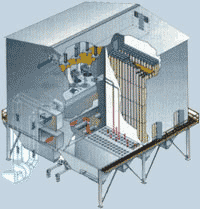 WESCO Environmental, Inc. can accommodate your Baghouse fabric filter maintenance needs with our professional staff and impeccable safety record. We have a proven track record within the particulate control industry and can mobilize within 24 hours to take care of your emergency outage needs. WESCO Environmental, Inc. can accommodate your Baghouse fabric filter maintenance needs with our professional staff and impeccable safety record. We have a proven track record within the particulate control industry and can mobilize within 24 hours to take care of your emergency outage needs.
W.E.I. can assist you with the following types of baghouse work:
•Baghouse Inspections & Leak Testing
•Filter Bag & Cage Replacement
•ESP to Baghouse Conversions
•Ductwork Repairs
•Tube Sheet Repairs
•Hopper Maintenance & Repairs
•Conveyor & Vacuum System Repairs
With increased attention on the environment and air pollution control, it has become more important than ever to ensure the proper operation of your particulate control systems. Whether you are using ESP or baghouse units, W.E.I. is ready to partner with your facility to ensure the longevity and efficient operations of your particulate control systems.
Contact W.E.I. today to discuss the details of baghouse needs.
ABOUT BAGHOUSES
Fabric filtration is one of the most common air pollution control techniques used to collect particulate matter. Baghouses are fabric filters used to filter fly ash from fossil fuel fired boilers, municipal and hazardous waste incinerators, and a number of other industrial processes. In many industries fabric filters have become as popular as electrostatic precipitators for removing up to 99.9% of particulate laden gas streams. Electrostatic Precipitators (ESP), baghouse fabric filters are very effective for fine particulate control. Baghouses can also be integrated with acid gas controls providing an added dimension not possible with some other forms of particulate control.
Baghouse fabric filters consist of the six main components; filter media, filter cleaning mechanisms, fans, collection hoppers, discharge devices, and an outer shell.
The filter medium consists of the fabric bags and their support structure. Most baghouse designs consist of cylindrical bags which are available in many different types of felted fabric and woven materials. Filter bags may be supported at the top and bottom or by internal cages. Particles are either collected on the inside or the outside of the filter bags depending on the individual baghouse design.
There are several types of bag cleaning mechanisms used to remove the caked particles from the filter bags. The four most common are shaking, reverse air, pulse jet, and sonic mechanisms.
Particulate laden gas is either pushed or pulled through the baghouse by a fan. When gas is pushed through a baghouse it is known as a positive pressure baghouse. When the fan is locate on the downstream side of the baghouse thus pulling gas through the filter media, it is termed a negative pressure baghouse.
Collection hoppers are used to temporarily store the collected ash that is dislodged from the filter bags by the cleaning mechanism processes. Many hoppers are designed to include strike plates, rappers, and/or vibrating mechanisms to assist in dislodging caked dust inside the hopper when discharging the particulate matter.
A discharge device is located at the bottom of a hopper and facilitates the emptying of the collection hoppers. Most industrial baghouses utilize automatic, continuous discharge devices to facilitate continuous operations. These include double dump devices, rotary airlock valves, screws, slide gates, hinged doors, and drawers.
Utility companies have been using fabric filters on coal-fired boilers since the mid 1970s and because of the advances in their design and operation, fabric filters have become a preferred technology for the control of particulate matter.
|












